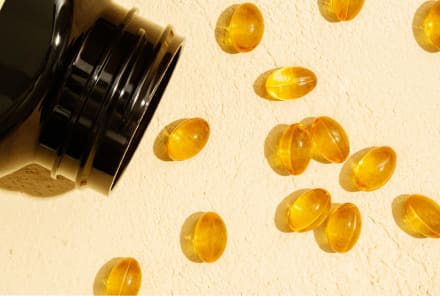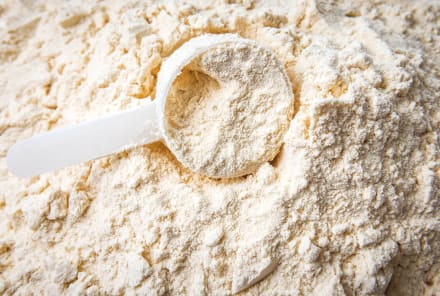Advertisement
How To Completely Eliminate Sugar From Your Life In 2 Months

Ever wondered why you couldn’t lose weight, or couldn’t seem to stick to a healthy diet? It’s likely that you were roped in by a sugar addiction and didn’t even know it. Here’s a five-step plan to help you cut cravings for the sweet stuff and start filling up on whole foods. Eating this way won't just help you kick sugar to the curb—you'll feel better, lighter, and more energized. Plus, you'll find it so much easier to stick to your healthy weight.
Phase 1: Eliminate Sugary Beverages
Time: 1 to 2 weeks
Why: There are many culprits: soft drinks, sweetened waters, coffee drinks, energy drinks, fruit drinks, and even apple juice. In fact, apple juice can be a combination of apple flavoring and 100% sweetener derived from concentrated fructose from the apple, so it can be called 100% apple juice.
One problem is that the size of these beverages can be deceiving; they also can be a way in which more sugar and calories can sneak into your diet without your knowledge. A conventional 12-ounce serving of a typical sugar-sweetened carbonated beverage, for example, is approximately 150 calories. But people rarely drink one serving. In fast-food chains, convenience stores, and movie theaters, these beverages are offered in portions that can contain around 300 to 500 calories.
Even cutting just one serving per day has been shown to produce a weight loss of 1.1 pounds at six months, and 1.4 pounds at 18 months. That might not sound like a tremendous amount, but remember that many people are not drinking just one 12-ounce serving per day. Approximately half of Americans drink sugary beverages “on a given day,” and within this half, about 25% derive 200 or more calories from them.
How: If you’re a big drinker of sugary beverages, this can be a tough one, and going cold turkey is your best bet. This is because they are not a part of your new way of eating, and it’s not suggested that you allow even small amounts of them into your diet. They have no value, other than giving you pleasure, which you’ll be getting elsewhere from now on.
Make a list of all the sugary beverages you drink and create a plan for substitutes so you don’t feel tempted to cheat. Pour the ones you have at home down the sink, and take them off of your shopping list.
Phase 2: Eliminate Junk Foods
Time: 2 to 3 weeks
Why: You’ll most likely find these foods in vending machines, at sporting events, and at fast-food restaurants. However, you’ll also likely find them lining the shelves of your pantry.
In fact, they are most likely fueling your addiction. It’s important to identify the sources of unnecessary sugars in your diet and cut them out. This means you’ll have to cut sweet foods like cakes, cookies, candy bars, and ice cream as well as savory and salty foods like chips, popcorn, and pretzels, all of which are classic examples of junk food. This even includes seemingly healthy items like most granola bars, energy bars, fruit bars, caramel-laced rice cakes, and buttery crackers. You know junk food when you see it, and if you’re in doubt, it’s most likely junk food.
How: To eliminate junk foods from your diet, take a modified cold-turkey approach. These types of foods have no place in your diet, and you should work to get rid of them all. Much like sugar-sweetened beverages, they are very likely fueling the vicious cycle of your dependence on them. Some people can vow to eat no more junk food at this phase and be fine, but you might need to taper down your intake more slowly and eliminate these items one by one.
If you tend to eat a lot of junk food, make a list of the items that you tend to overeat, and then figure out which ones are highest in sugars and other carbohydrates. You can then prioritize which ones should be eliminated first.
For example, if you regularly eat high-sugar-equivalency items such as coffee cake and candy bars and have a pair of prepackaged cupcakes for dessert every night, phase these out first. Once you’re confident that you’ve moved past them, target other items on your list and cut them out next. Work your way down your list of common junk foods until you have eliminated them all.
The key to cutting out junk foods is replacing them with healthy alternatives (not substituting them with other junk foods).
Phase 3: Drastically Reduce Carbs
Time: 3 to 4 weeks
Why: When you reach this point, pat yourself on the back and congratulate yourself! You have eliminated the sugar-rich, empty calories from your diet. At this point, you should start to see and feel a change: you have fewer withdrawal symptoms and more energy, and there is a noticeable difference in the way that you look and feel about yourself.
While you have already reduced your intake of simple carbohydrates, like sugars from beverages, you still have to tackle complex carbohydrates, like breads, pastas, and rice. Both simple and complex carbohydrates affect your blood sugar in ways that can detract from your weight loss. If you eat them in excess, you will soon be craving other foods, often those that are high in sugar or largely consist of other carbohydrates.
Eating too many carbohydrates is like putting yourself on a roller coaster; your blood sugar zooms up shortly after you eat, then goes crashing down after a short time. Before you know it, you’re hungry because your body quickly digested the food; you’re craving more, and so the ups and downs continue. There is a way to get off of the roller-coaster ride and take control: reduce your intake of any carbohydrates that you abuse, and by abuse, we mean eating them not necessarily because you need them due to hunger, but because you want them to feel normal and to avoid the awful feelings associated with the withdrawal syndrome.
How: The process of cutting back on bread, pasta, rice, and so on will probably take more time than the previous two stages. This is largely because many people are heavily dependent on these types of complex carbohydrates as the primary constituents in many meals.
Instead of having toast for breakfast or a sandwich for lunch, you’ll need to come up with alternatives. Instead, you may opt for eggs and fruit for breakfast, and a large green salad with chicken on top (hold the croutons and the sugar-laced dressings) for lunch.
A good strategy is to list the carbohydrates that you tend to overeat most, and then cut them out one by one. Make it a rule of thumb that once you cut something out, you cut it out for good. Phase out breads and pastas first, then move on to cereals (unless you’re eating lots of highly sweetened cereals, in which case you should cut those out first, as they’re loaded with added sugars).
Next, phase out rices and other starches. For example, instead of having two cups of spaghetti for dinner, try having one cup and topping it with some lean meat to complete your meal. Eventually, you could replace the pasta with a vegetable—squash is a great substitute. By making small changes as you feel ready and continuing to keep track of what you’re eating, you’ll find yourself transitioning to a new way of eating with ease.
Phase 4: Reduce Hidden Sugars
Time: 1 to 2 weeks
Why: Dressings, sauces, and condiments may seem to merely add some flavor to your food, but they often add sugars that can work against you. A small amount of some condiments can add whole grams of sugar to your meal. Furthermore, we usually don’t use only one packet of sweet-and-sour sauce or ketchup; instead, we douse our food in these sugar-rich add-ons. Consequently, you might think that you’re doing all you can to reduce the amount of sugars you’re consuming, but that might not be the case if you continue to eat foods with hidden sugars.
Note that there are many foods that appear to be “diet” foods that actually might be bad to eat for your new eating plan. Many foods labeled as “diet,” “low-fat,” or “no-fat” replace the fat content with more carbohydrates. We tend to see “low-fat” and think this is a healthy option, but if “low-fat” is a synonym for “high-sugar,” then it is clearly a no-no.
There are also products on the market now that are labeled “sugar-free,” which appeal to people who are either diabetic or trying to restrict their sugar intake. Proceed cautiously with these products as well. While these products may indeed be sugar-free, they may still contain a lot of fast-metabolizing carbohydrates.
How: You may find, as you progress from one phase to the next, that reducing hidden or lesser-known sugars goes more smoothly than previous phases. This is because you’ll already have established healthy eating habits and be used to making substitutions for the foods that you used to overeat. The goal here is to use your knowledge of nutrition labels to identify the foods that you eat which contain hidden sugars and to identify sensible replacements for them, like the ones we suggest in the next chapter.
Phase 5: Maintain Your New Way of Eating
Time: The rest of your life
Why: This is a way of eating, not a temporary diet. That means once you cut out these sugary, carb-rich foods, you’ll continue eating this way for the rest of your life. If you only eat this way temporarily and eventually go back to your old ways of eating, you can be certain that the addiction will rope you back in pretty quickly. The four phases just described lay the foundation for a healthy eating style that you can maintain forever. The key to achieving your goals lies in your knowledge of where sugars exist and what you can replace them with, and the consistent desire and dedication to follow what you know.
How: Remember, each phase takes time. Follow the allotted time guidelines—as a minimum. Be patient with yourself. If you find that one phase takes longer than what is listed or than you expected, that’s fine! The important point is to achieve the goal of that phase, not how quickly you do it. Try to identify why certain phases are more difficult than others. This may help you to troubleshoot and figure out ways to transition through that phase that are specific to your needs. Invest the time you need; it will be well worth it in the long run.
Reprinted with permission from Why Diets Fail (Because You’re Addicted to Sugar): Science Explains How to End Cravings, Lose Weight, and Get Healthy by Nicole M. Avena, PhD, and John R. Talbott (Ten Speed Press, © 2014).
Watch Next
Enjoy some of our favorite clips from classes
Enjoy some of our favorite clips from classes
What Is Meditation?
Mindfulness/Spirituality | Light Watkins
Box Breathing
Mindfulness/Spirituality | Gwen Dittmar
What Breathwork Can Address
Mindfulness/Spirituality | Gwen Dittmar
The 8 Limbs of Yoga - What is Asana?
Yoga | Caley Alyssa
Two Standing Postures to Open Up Tight Hips
Yoga | Caley Alyssa
How Plants Can Optimize Athletic Performance
Nutrition | Rich Roll
What to Eat Before a Workout
Nutrition | Rich Roll
How Ayurveda Helps Us Navigate Modern Life
Nutrition | Sahara Rose
Messages About Love & Relationships
Love & Relationships | Esther Perel
Love Languages
Love & Relationships | Esther Perel

















